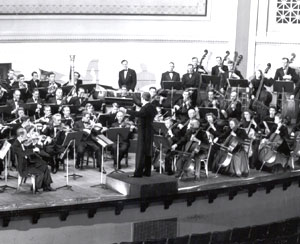
Symphony Orchestras
Tennessee has two professional orchestras designated as “regional” (Nashville and Memphis) and three that fall in the “metropolitan” status (Chattanooga, Jackson, and Knoxville). Other cities with part-time orchestras are Oak Ridge, Murfreesboro, Johnson City, Kingsport, and Germantown, and the University of the South in Sewanee hosts an annual summer music festival.
There were attempts at sustaining symphonic organizations in Nashville during the late 1920s, but the current Nashville Symphony Orchestra (NSO) owes much to Walter Sharp (1911-1970). Desiring to raise the cultural awareness of his fellow Nashvillians, Sharp acquired financial support for the new NSO through his connections with the Nashville elite. Under his supervision, a twenty-seven-member board of directors was elected and a five-member executive committee and an official charter were drawn up in June 1946 for the Nashville Civic Music Association.
From 1946-51 William Strickland was conductor of the new orchestra which debuted at 8:30 p.m. December 10, 1946, at the War Memorial Auditorium. From the onset, he insisted the new group be organized, maintained, and operated as a professional organization. Strickland demanded high standards of musicianship for its members, set strict codes for performance dress, and insisted rehearsals be held in privacy. Musicians came from local radio orchestras and vaudeville, and instructors from the Nashville Conservatory, George Peabody College, Ward-Belmont Conservatory, and Fisk University were enlisted as principles. Other Nashville conductors have been Guy Taylor (1951-59), Willis Page (1959-67), Thor Johnson (1967-75), Michael Charry (1976-82), and Kenneth Schermerhorn (from 1983). In 1980 the orchestra began performances at Andrew Jackson Hall in the Tennessee Center for the Performing Arts. Including pop concerts, the NSO has a thirty-seven-week season and employs seventy core musicians.
Though there were several earlier attempts under various titles, the most successful organization and forerunner to the present Memphis Symphony Orchestra (MSO) was developed by Burnet C. Tuthill, music department head at Southwestern College and later president of the Memphis College of Music (1939). The orchestra benefited from the fund-raising efforts of the newly formed Memphis Symphony Society. Including all skill levels, the largely amateur orchestra was augmented by professionals and performed four to five concerts per season. Their first concert, featuring soloists engaged through Tuthill’s connections with the Cincinnati Conservatory, was held in the Goodwyn Institute Auditorium in March 1939. World War II caused interruptions, and there were no plans made for the 1947-48 season.
Meanwhile, Noel Gilbert initiated the Memphis Concert Orchestra, a part-time pops group in 1949. With funding from the Memphis Federation of Musicians, the orchestra performed five to six concerts at the Overton Park Shell during the summer season until the mid-1970s. The remnants of this group can be found in the current Memphis Civic Orchestra and the Germantown Symphony Orchestra.
Vincent DeFrank, who had been first cellist under Tuthill, began a chamber group in 1952 with the fund-raising efforts of the new Memphis Orchestral Society and the Memphis Arts Council. He maintained the group over the next eight years as it grew into the Memphis Symphony Orchestra by 1960. In 1981 DeFrank announced his retirement. Alan Balter became the musical director in 1984. The MSO, performing one hundred concerts over a thirty-eight-week season, supports thirty-five core musicians.
The current Knoxville Symphony Orchestra (KSO), the oldest continuing orchestra in the Southeast, was founded by Bertha Walburn Clark, who conducted the group from 1935 to 1946. She was followed by Lamar Stringfield (1946-47), David Van Vactor, “father of the modern KSO” (1947-72), Arpad Joo (1973-78), Zoltan Rozsnyai (1978-85), and Kirk Trevor (1985 to present). A sixteen-piece core orchestra was established in the late 1970s and the season expanded to 129 annual performances. The subscription orchestra maintains a thirty-week season performing in the Civic Auditorium with additional classical, pops, and educational series.
There was symphonic activity in Chattanooga as early as 1909, and by 1932 Arthur Plettner had formed the Chattanooga Symphony Orchestra (CSO). Melvin Margolin was the ensemble’s first conductor in 1933. From 1956 to 1965 Julius Hegyi served as conductor and was succeeded by Charles Gabor temporarily until being replaced by Richard Cormier. Cormier remained as musical director through the 1983 season. In 1985 the CSO merged with the Chattanooga Opera Association, and Vakhtang Jordania was engaged as conductor and artistic director. Robert Bernhardt has been musical director of the association since 1992, performing nineteen performances per season including three operas and four pops concerts.
The Jackson Symphony Orchestra (JSO) was founded in 1961 and conducted by James Petty until his retirement in 1985. After a season of guest conductors, Jordan Tang became musical director and conductor in 1986. The orchestra’s size and budget currently rank fifth in Tennessee. With only 32 percent of its members residing in Jackson, the symphony hires supporting musicians from neighboring orchestras and colleges. The JSO currently schedules approximately twelve performances each season.



